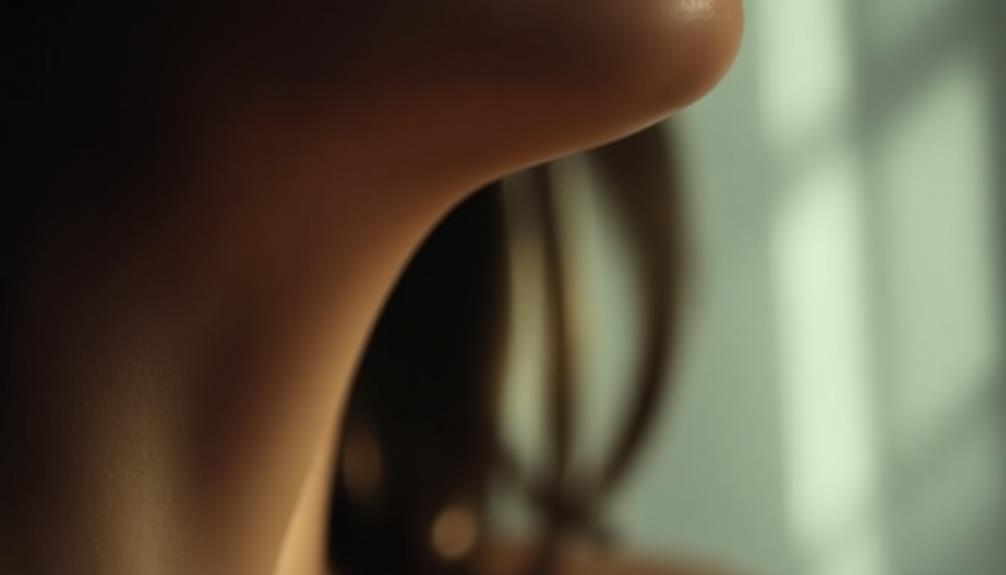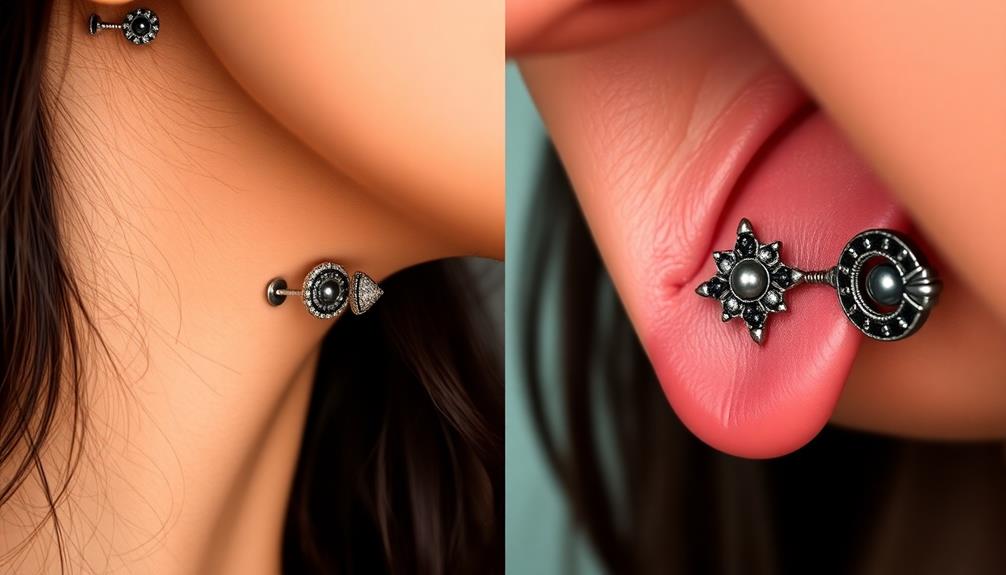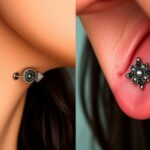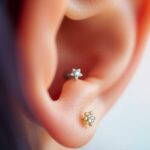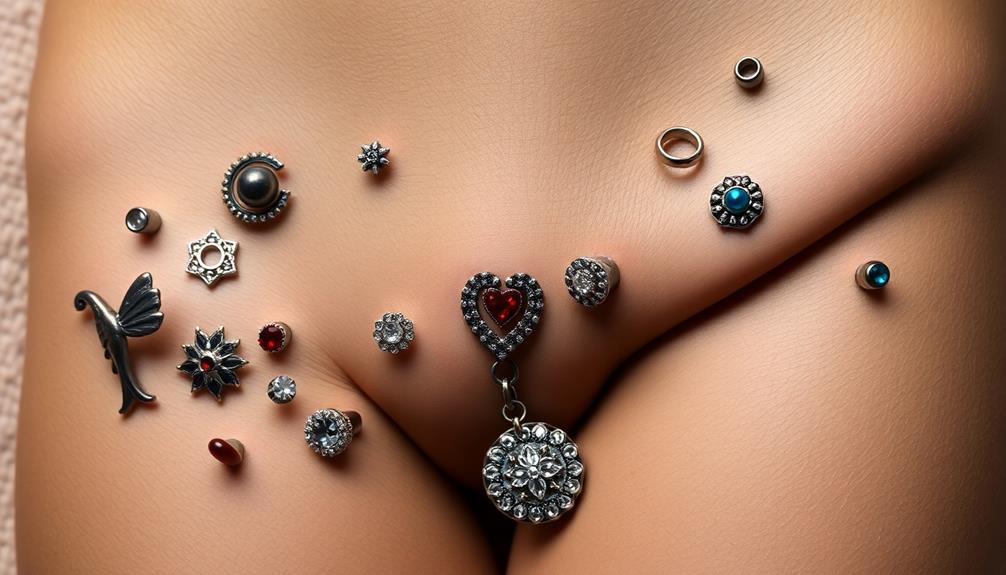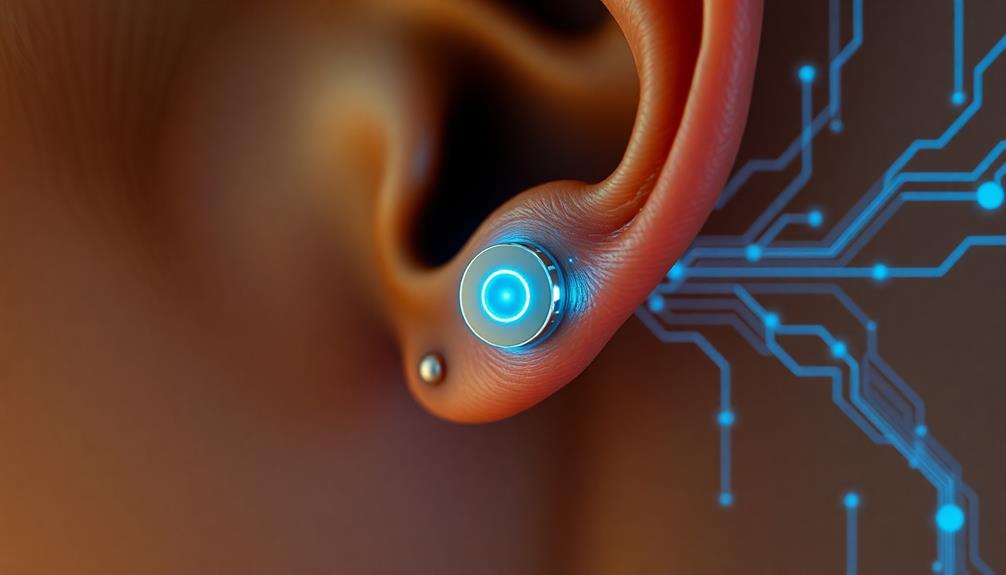Clitoral hood piercings, particularly the Vertical Clitoral Hood (VCH), can enhance your sexual pleasure considerably. The procedure involves a licensed professional using a sterile needle and clean equipment. You'll need to follow aftercare guidelines closely, with healing typically taking 4 to 8 weeks. It's essential to choose a reputable piercer to minimize risks, like infections or complications. Your choice of jewelry matters too; consider materials like surgical stainless steel or titanium for comfort. If this intriguing option piques your interest, there's plenty more to discover about the process, care, and benefits that come with it.
Key Takeaways
- Clitoral hood piercings, especially Vertical Clitoral Hood (VCH), enhance sexual pleasure and sensitivity during intimate activities.
- Healing typically takes 4 to 8 weeks, and proper aftercare is crucial to prevent complications.
- Choose a reputable, licensed piercer for safety, and ensure a sterile environment during the procedure.
- Recommended jewelry includes curved barbells and rings made from hypoallergenic materials like surgical stainless steel or titanium.
- Monitor for signs of infection, and avoid sexual activities for at least 6-8 weeks post-piercing to ensure proper healing.
Overview of Clitoral Hood Piercings

Clitoral hood piercings, particularly the Vertical Clitoral Hood (VCH) piercing, are an increasingly popular choice for those looking to enhance their sexual pleasure. Located on the skin above the clitoris, this piercing can stimulate sensitive areas, providing heightened sensations during intimate moments.
The healing time for a clitoral hood piercing typically ranges from 4 to 8 weeks, making proper aftercare vital. Adhering to aftercare guidelines helps prevent complications like infections or jewelry embedding.
When considering a clitoral hood piercing, it's important to assess your anatomy first. A deep enough clitoral hood is essential for successful placement and to avoid potential complications.
You'll also want to choose the right jewelry types, with options like curved barbells and rings. Recommended materials include surgical stainless steel, titanium, or solid gold to minimize allergic reactions.
As you think about this piercing, remember that most studios require clients to be at least 18 years old. Researching and selecting a reputable piercer experienced in genital piercings will guarantee a safe and satisfying experience, setting you on the path to enhanced sexual pleasure.
The Piercing Process

When you decide to get a clitoral hood piercing, a licensed professional will first clean the area and mark the spot for the needle.
After the quick piercing, they'll thread jewelry through the skin and provide you with essential aftercare instructions.
Following these guidelines is vital for preventing infections and ensuring your piercing heals properly.
Professional Piercing Techniques
Before undergoing a clitoral hood piercing, it's vital to choose a licensed professional, preferably one registered with the Association of Professional Piercers (APP). This guarantees they adhere to safety and hygiene standards.
The procedure begins with the professional piercer cleaning your skin and marking the desired location for the piercing. They'll then use a sterile needle to create the hole, through which they'll thread your chosen jewelry.
You'll have various jewelry options, such as curved or straight barbells, but it's important to select materials that minimize the risk of allergic reactions and infections. Surgical stainless steel or titanium are excellent choices for this purpose.
During the piercing, the piercer will maintain strict hygiene practices, using sterile, disposable instruments and wearing gloves to guarantee infection prevention.
After the piercing, you'll receive specific aftercare instructions to promote proper healing. These typically include cleaning the area with a saline solution to prevent complications.
Aftercare Instructions Provided
Aftercare is vital for your new piercing's healing process. Following the instructions provided by your piercer will help guarantee a smooth recovery. Here's what you need to keep in mind:
- Clean the area: Use a saline solution to clean the piercing 2-3 times daily.
- Practice hygiene: Always wash your hands thoroughly before touching the pierced area to prevent introducing bacteria.
- Avoid sexual intercourse: Refrain from any sexual activity for at least 6-8 weeks to minimize the risk of infection and allow for proper healing.
- Monitor for complications: Keep an eye out for any signs of infection, such as increased pain, swelling, or unusual discharge. If you notice any concerning symptoms, consult your piercer or a healthcare professional.
Additionally, wearing tight, clean cotton underwear can help prevent snagging and provide comfort during the healing process.
Taking these aftercare steps seriously can greatly reduce the chances of complications and guarantee your piercing heals beautifully.
Ensuring Safe Practices

Before getting a clitoral hood piercing, you need to verify your piercer's credentials with the Association of Professional Piercers (APP).
Make sure the environment is clean and that they use sterile, disposable instruments to reduce infection risks.
Avoid places that use piercing guns, as they can lead to more complications than a professional needle piercing.
Verifying Piercer Credentials
Choosing the right piercer is important for a safe and successful clitoral hood piercing. To make sure you're making the best choice, follow these steps to verify piercer credentials:
- Check Registration: Confirm that the piercer is registered with the Association of Professional Piercers (APP) to guarantee their credibility and adherence to safety standards.
- Assess Experience: Look for piercers with specific experience in genital piercings, as this specialization is essential for a safe procedure.
- Inspect the Studio: Verify the piercing studio maintains a clean and sanitary environment, which is critical for reducing infection risks during your piercing.
- Inquire About Instruments: Make certain the piercer uses sterile, new, and disposable instruments. Avoid establishments that use piercing guns to uphold proper hygiene practices.
Additionally, don't forget to ask about aftercare instructions and follow-up procedures.
Being well-informed about these aspects will help you prepare for your post-piercing care, promoting piercing safety and a smoother healing process.
Sterile Environment Importance
A clean and sterile environment plays an essential role in the safety of clitoral hood piercings. When it comes to genital piercings, minimizing the risk of infections is critical since bacteria can easily enter through punctured skin.
You should guarantee that the piercing studio adheres to strict hygiene protocols recommended by the Association of Professional Piercers (APP). This includes maintaining cleanliness and proper sterilization of workspaces and tools.
Your piercer should always use disposable instruments to prevent cross-contamination during the procedure. Compliance with health regulations and proper sterilization methods, such as autoclaving, is crucial for creating a safe piercing environment.
Both the piercer and their staff must wash their hands and wear gloves to further guarantee a sterile environment throughout the process.
Before getting your clitoral hood piercing, don't hesitate to ask the piercer about their hygiene practices. It's your body and health at stake, so being informed about the studio's commitment to cleanliness is essential.
Proper Instrument Usage
When getting a clitoral hood piercing, guaranteeing proper instrument usage is essential for your safety.
Using the right tools and following strict protocols minimizes the risk of infections and nerve damage. Here are some key points to take into account:
- Sterile Instruments: Always confirm that the piercing instruments are sterile, new, and preferably disposable to prevent infections during your procedure.
- Autoclave Sterilization: Verify that your piercer uses an autoclave for sterilization, as piercing guns aren't recommended for genital piercings due to safety concerns.
- Professional Registration: Confirm that your piercer is registered with the Association of Professional Piercers (APP) to guarantee compliance with safety standards and practices.
- Gloves and Hygiene: Both the piercer and their staff must wash their hands and wear gloves throughout the process, maintaining a clean and sanitary environment.
Proper handling of instruments and strict adherence to these safety protocols greatly reduces the risk of complications.
Potential Risks and Complications

Getting a clitoral hood piercing can be an exciting decision, but it's important to be aware of the potential risks and complications involved. The risks associated with clitoral hood piercings include bacterial infections, bleeding, and nerve damage, which can lead to complications like loss of sensation or chronic pain.
If you experience persistent pain, swelling, foul-smelling discharge, or fever, it's imperative to consult a professional piercer or a medical provider immediately.
Allergic reactions to jewelry materials, particularly nickel, may occur, so it's important to choose hypoallergenic materials like titanium or surgical stainless steel.
Additionally, if proper hygiene and sterilization protocols aren't followed during the piercing procedure, there's a risk of developing serious infectious diseases, such as hepatitis B, C, or HIV/AIDS.
To minimize these risks, always select a skilled piercer with experience in clitoral hood piercings. They should adhere to strict hygiene standards to guarantee a safe procedure.
Types of Clitoral Hood Piercings

Clitoral hood piercings come in several popular styles, each offering unique sensations and aesthetic appeals. If you're considering one, here are some types to explore:
- Vertical Clitoral Hood (VCH): The most popular type, this piercing is located above the clitoris, known for enhancing sensitivity and aesthetics.
- Horizontal Clitoral Hood (HCH): Similar to the VCH but positioned horizontally, the HCH provides a different visual appeal and sensation, allowing for personal customization.
- Triangle Piercing: Located beneath the clitoris, this less common option offers stimulation and adds to the overall aesthetic.
- Labia Piercings: While not exclusively clitoral hood piercings, multiple piercings along the labia allow for greater customization and personal expression, impacting sensitivity and healing times.
Additionally, you might be interested in male genital piercings like the Prince Albert (PA), which enhances sensitivity similar to clitoral hood piercings.
Each type provides unique benefits, so consider your preferences carefully when deciding on the perfect piercing for you!
Aftercare Instructions

After getting your clitoral hood piercing, proper aftercare is vital for healing and preventing complications.
You'll need to clean the area regularly and avoid any activities that could irritate the piercing.
Let's go over some essential cleaning guidelines, ways to avoid complications, and tips for maintaining your jewelry.
Cleaning Guidelines
To guarantee your clitoral hood piercing heals properly, it's important to establish a consistent cleaning routine. Follow these cleaning guidelines to promote healing and prevent infection:
- Clean the piercing site 2-3 times daily with a saline solution.
- Use unscented antibacterial soap when washing, confirming it doesn't touch the piercing directly.
- Hold up the area while cleaning to avoid contact with soap, and gently twirl the jewelry to remove any crusting.
- Monitor the area regularly for signs of infection, such as redness, swelling, or unusual discharge.
Additionally, avoid sexual activity for at least 6-8 weeks after your piercing. This limit minimizes irritation and the risk of infection during the healing process.
Remember, proper aftercare is vital for a successful healing journey. If you notice any concerning signs of infection, consult your piercer immediately.
Avoiding Complications
While your clitoral hood piercing is healing, it's vital to take proactive steps to avoid complications. Start by cleaning the piercing with a saline solution or unscented antibacterial soap 2-3 times daily. This routine minimizes the risk of infection and promotes healing.
Avoid touching or playing with the jewelry, as this can lead to irritation, embedding, and other complications. For at least 6-8 weeks, steer clear of sexual intercourse and any activities that might irritate your piercing.
During this time, monitor for symptoms of infection, such as increased redness, swelling, discharge, or persistent pain. If you notice any of these signs, consult a professional piercer immediately.
Maintaining proper hygiene is essential. Wear tight, clean cotton underwear to prevent snagging and maintain a sanitary environment around your piercing.
Following these aftercare instructions will help guarantee your clitoral hood piercing heals correctly and reduces the risk of complications. Remember, taking these steps seriously can make a significant difference in your healing journey.
Jewelry Maintenance Tips
Proper jewelry maintenance is essential for ensuring your clitoral hood piercing remains healthy and free from complications. Here are some key tips to follow:
- Clean the piercing: Use a saline solution 2-3 times daily to clean the area. Avoid contact with soap or other irritants.
- Avoid tight clothing: During the healing process, steer clear of tight clothing that may snag or irritate your piercing. Opt for loose, breathable fabrics instead.
- Monitor for signs of infection: Keep an eye on the area for unusual redness, swelling, discharge, or persistent pain. If you notice any symptoms, consult a professional piercer immediately.
- Wait until fully healed: Before changing jewelry, wait until your piercing has fully healed, typically within 4-8 weeks.
When you're ready, consult a professional piercer for guidance to prevent complications.
Jewelry Options and Materials
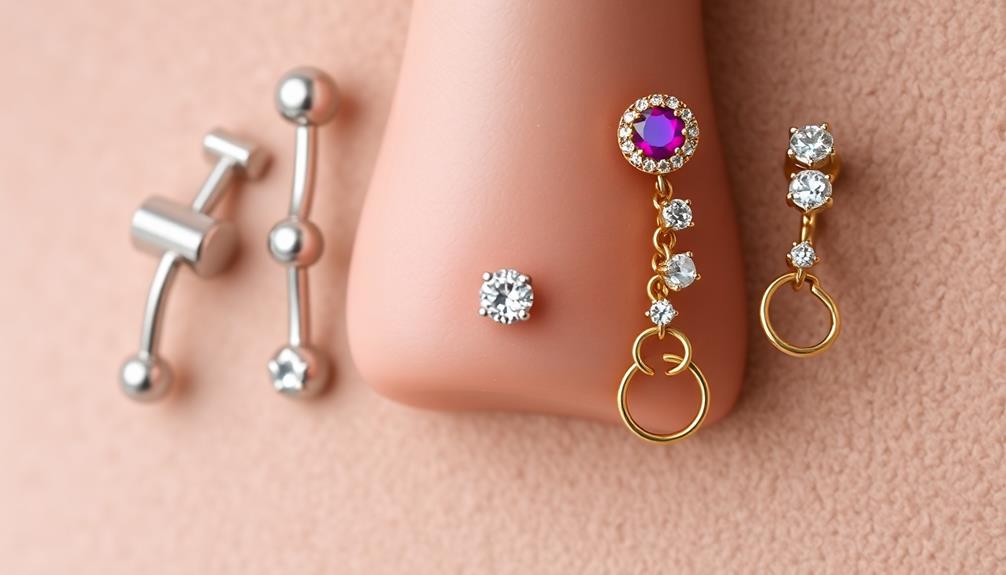
When exploring jewelry options for clitoral hood piercings, you'll often find that curved barbells are the most popular choice due to their comfort and protective design. They fit snugly and reduce the risk of irritation.
Straight barbells and hoops are also available, but they may not offer the same level of comfort.
For materials, consider solid 14k gold for a luxurious touch. If you prefer something more affordable, surgical stainless steel is a great choice, as it has a low nickel release.
Titanium is hypoallergenic, making it ideal for sensitive skin, ensuring you won't experience adverse reactions.
Remember that proper sizing is essential. If the jewelry is too small or too large, it can lead to embedding or closure of the piercing.
To avoid complications, consult with a professional piercer who can recommend the best size and style based on your anatomy.
Don't hesitate to experiment with different jewelry options to enhance your personal pleasure and aesthetic appeal.
With so many flashy choices available, you can find pieces that not only feel good but also look stunning.
Healing Process and Timeline

Typically, the healing process for a Vertical Clitoral Hood (VCH) piercing lasts between 4 to 8 weeks, but it can vary based on your individual anatomy and how well you follow aftercare instructions.
Proper aftercare compliance is essential for a smooth healing duration, so keep the following tips in mind:
- Cleaning: Clean the piercing with a saline solution 2-3 times daily to prevent infection.
- Sensitivity: Expect increased sensitivity in the area; avoid activities that could irritate the piercing.
- Sexual Activity: Steer clear of sexual activity for at least 6-8 weeks post-piercing to guarantee proper healing.
- Signs of Infection: Watch for signs of complications, like excessive redness, swelling, persistent pain, or unusual discharge.
If you notice these, consult a professional piercer.
Enhancing Sexual Pleasure

Clitoral hood piercings, particularly the Vertical Clitoral Hood (VCH) type, can greatly enhance your sexual pleasure. This body modification is known for providing direct clitoral stimulation during various sexual activities, often leading to heightened orgasmic experiences.
Many individuals report increased sensitivity and enjoyment after getting a VCH piercing, with studies showing that such piercings can positively influence sexual satisfaction and overall confidence.
The jewelry used in a VCH piercing plays a significant role in enhancing pleasure. During intercourse or masturbation, the movement of the jewelry can intensify clitoral stimulation, making your experiences more varied and enjoyable.
Users often find that this added stimulation leads to more satisfying encounters, transforming intimate moments into something extraordinary.
Additionally, the aesthetic appeal of a VCH piercing can boost your self-esteem, allowing you to feel more confident during intimate interactions.
As you embrace this body modification, you might find that your sexual confidence and enjoyment increase, leading to a more fulfilling sex life.
Considerations Before Piercing

Before you decide to get a clitoral hood piercing, it's essential to reflect on several important factors that can impact your experience and satisfaction. Here are some key considerations:
- Age Requirements: Most studios require you to be at least 18, while some allow 16-year-olds with parental consent.
- Reputable Piercer: Research and choose a licensed, experienced piercer, ideally one registered with the Association of Professional Piercers (APP).
- Personal Anatomy: Familiarize yourself with your anatomy, especially the elasticity of your clitoral hood, to assess suitability for the piercing.
- Motivations: Reflect on your reasons for wanting the piercing, as understanding your motivations can guide your decision.
Additionally, prior to the procedure, have a consultation with your piercer to discuss hygiene practices and preferred jewelry styles.
Safety is paramount; verify the studio follows strict hygiene protocols to minimize infection risks.
Frequently Asked Questions
What to Expect When You Get Your VCH Pierced?
When you get your VCH pierced, expect a quick procedure with a surprising sensation. You might experience some initial bleeding and need to avoid sexual activity for 6-8 weeks to guarantee proper healing.
Conclusion
As you stand at the crossroads of self-expression and intimacy, consider clitoral hood piercings like a key to a hidden door. This journey into body art can open up new sensations and confidence, but it's essential to tread carefully, ensuring safety and understanding. Just as a garden flourishes with care, so too will your experience. Embrace the adventure, but always listen to your body, for it holds the wisdom of your desires and boundaries.
Hi, my name is Danielle, and I’m an author for piercings-body.com. I have a passion for writing and love to share my knowledge on all things body piercing-related. I’m also a huge advocate for safe body modification practices and believe everyone should be able to make informed decisions about their bodies. When I’m not writing or blogging, I enjoy spending time with my family and friends, practicing yoga, and exploring new places.

